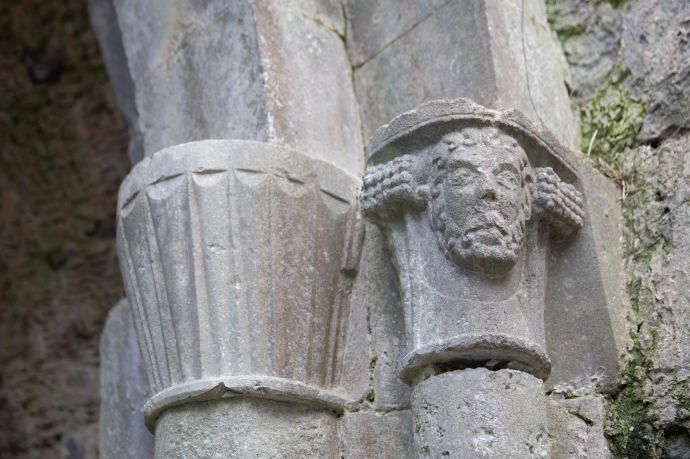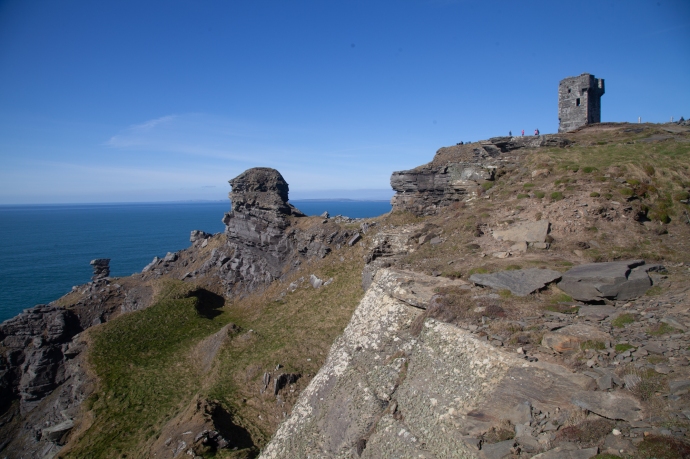I can’t believe that in the five years I’ve lived here I hadn’t come across this place before. It wasn’t until I was chatting to my friend Oliver O’Connell, a man who knows the Burren as well as anyone, that it came up in conversation. When he saw the blank look on my face, he said “let’s forget about our plans. I’ll show it to you”.
It is hard not to be impressed when you first see it. A stunning location in a green valley surrounded by the treeless rocky hills it has towered over the landscape for centuries. A huge symbol of Church and Chieftain power. Surrounded by natural beauty and itself the stuff of legends.

Corcomroe Abbey in its fertile valley

Another view of Corcomroe Abbey bathed in sunshine.

Corcomroe Abbey viewed from the east. Note the repaired roof over the nave
It was founded for the Cistercian monks around 1195 and the church we see today was constructed in the early 13th century. The name is said to have derived from Corcamruadh, cor meaning district; cam, quarrel and ruadh, red. The church was also dedicated, more poetically, to St Mary of the Fertile Rock. It is believed that the building was commissioned by King Conor na Siudane Ua Briain (Conor O’Brien) King of the ancient territory of Thomond and a huge benefactor to the Church.
The continual relationship and support of the ruling families meant for a turbulent history for the monastery and led ultimately to its downfall. Many battles were fought in and around the Abbey and its ownership regularly changed hands. In 1268 Conor O’Brien was killed by Conor Carrach O’Loughlain, though the O’Brien’s maintained control. The monks retrieved his body and interred him in the Abbey. In 1317 yet another battle was fought this time between factions of the O’Briens and the Abbey was used as a barracks. By the end of the 14th century, the O’Cahans (O’Kane or Keane) from Derry took control of the Abbey’s lands. Sometime in the 15th century (though it is unknown how) the Tierney family took control.
With the dissolution of Catholic monasteries due to the English Reformation the Abbey and land was granted to the Baron of Inchiquin and Earl of Thomond, Murrough O’Brien, in 1554 and then in 1702 to Donat O’Brien of Dromoland, whose family retained the abbey until the 1870s when it passed into public hands.
Meanwhile the monks continued to tend the fields and maintain the abbey as circumstances allowed, but the political climate led to continued decline until the last abbott was appointed in 1628.
It is built to a standard Cistercian plan, though with some notable variations and the extreme decoration is unusual. The stonework is of such high quality it is said to have led to the ultimate demise of the five stonemasons involved, who were executed by O’Brien to prevent them repeating their masterpiece somewhere else. Hopefully they got their reward in the next life.
Over the nave there is a roof (repaired very sensitively) with exquisitely carved rib vaulting with herringbones and some floral decoration. It is lit by three lancet windows. Either side of the nave are columns with detailed carvings of human heads and flowers. Including what look like bluebells and fleur-de-lys. What is intriguing to me is the lack of symmetry of these decorated columns. This lack of symmetry is seen elsewhere, for instance in the arch over a niche on the north transept. Was this intended or was it a result of different masons working on different areas or maybe a thumbing of noses to architectural orthodoxy? At the base of the columns are further carvings of flowers (?). One intrigued me. It is unidentifiable, though to me it looks remarkably like a map of Australia which wouldn’t be ‘discovered’ for another 550 years! Such prescience.
There are many other notable features in the nave. A niche tomb on the north wall houses a life size effigy of Conor O’Brien. Beautifully carved it is one of the few examples of a depiction of an Irish chieftain surviving. He is in a serene repose, wearing a robe with pleats and a crown with fleur-de-lys decoration. He once held a sceptre apparently in his left hand (now gone) and his right holds a reliquary suspended round his neck. Love the little touch of his feet resting on a cushion. Love also that we are able to see it in situ, with no guard rails rather than have it relocated to a museum somewhere. Above this is a detailed carving of a bishop. There is an intricate sedilia (where the priests sit during the service) on this same wall.
Where the north and south transepts intersect the presbytery, there are several crossing arches in remarkable condition and set into the floor throughout are grave slabs. I am a lover of gravestones and here are some of the finest I have seen in Ireland, especially those close to the altar (where the rich were allocated space). And some of the oldest, with one I saw dating back to the late 1600s. This I think reflects the patronage by the elite who could afford intricate engraving that has survived.

Corcomroe Abbey. Archway over niche in north transept. Note again assymetrical carvings with bluebells on left and fleur-de-lye on right.

Corcomroe Abbey Carved head on right hand column in southern transept

Corcomroe Abbey. Carved head and flowers on left hand columns in the south transept

Corcomroe Abbey. Effigy of Conor O’Brien.

Corcomroe Abbey. Grave slab. Elegant simplicity. Pray for the soul of Martin Burke and Posterity 1775

Corcomroe Abbey. Oliver O’Connell examines a grave slab

Enter a cap
n
- tio

Corcomroe Abbey. Grave slab for John O’Dally and Marey Flanagane. Dated 1682. The oldest I saw.

Corcomroe Abbey. Double arch over sedilia on north wall of nave. Different decorative carvings on each column

Enter a caption

Corcomroe Abbey. Beautiful detailed carving of a bishop

Corcomroe Abbey. Tomb niche of Conor O’Brien underneath carving of a bishop.

Corcomroe Abbey. Unidentified carving. Map of Australia?

Corcomroe Abbey. Floral carving at base of columns.

Corcomroe Abbey. View of the columns supporting the arch over the nave. Note the assymetrical arrangemetn of carvings at the tops of the columns.

Corcomroe Abbey. Looking towards the nave showing the arches over the north and south transepts
A walk around Corcomroe is almost spiritual. You do feel some sort of presence. And it is not surprising that stories of this abbey are woven into Irish Culture in many ways other than the clinical history of battles and chieftains or its marvellous architecture.
Indeed it is said to be haunted by the ghosts of a poet named Cearbhall O’ Dalaigh and Eibhlin Kavanagh who eloped in the 15th century and wished to be secretly married at midnight on Christmas Eve. If you know the song Eileen Aroon, which is about this episode, then you know that it didn’t end well as Eibhlin’s father caught up with them that night.
You will also feel perhaps, when you walk around, the inspiration that Yeats must have had when he chose to use it as the backdrop for his play on Irish freedom, The Dreaming of Bones.
That feeling stayed with me long after. Thanks, Oliver, for introducing me to this special place. Highly recommend.





























